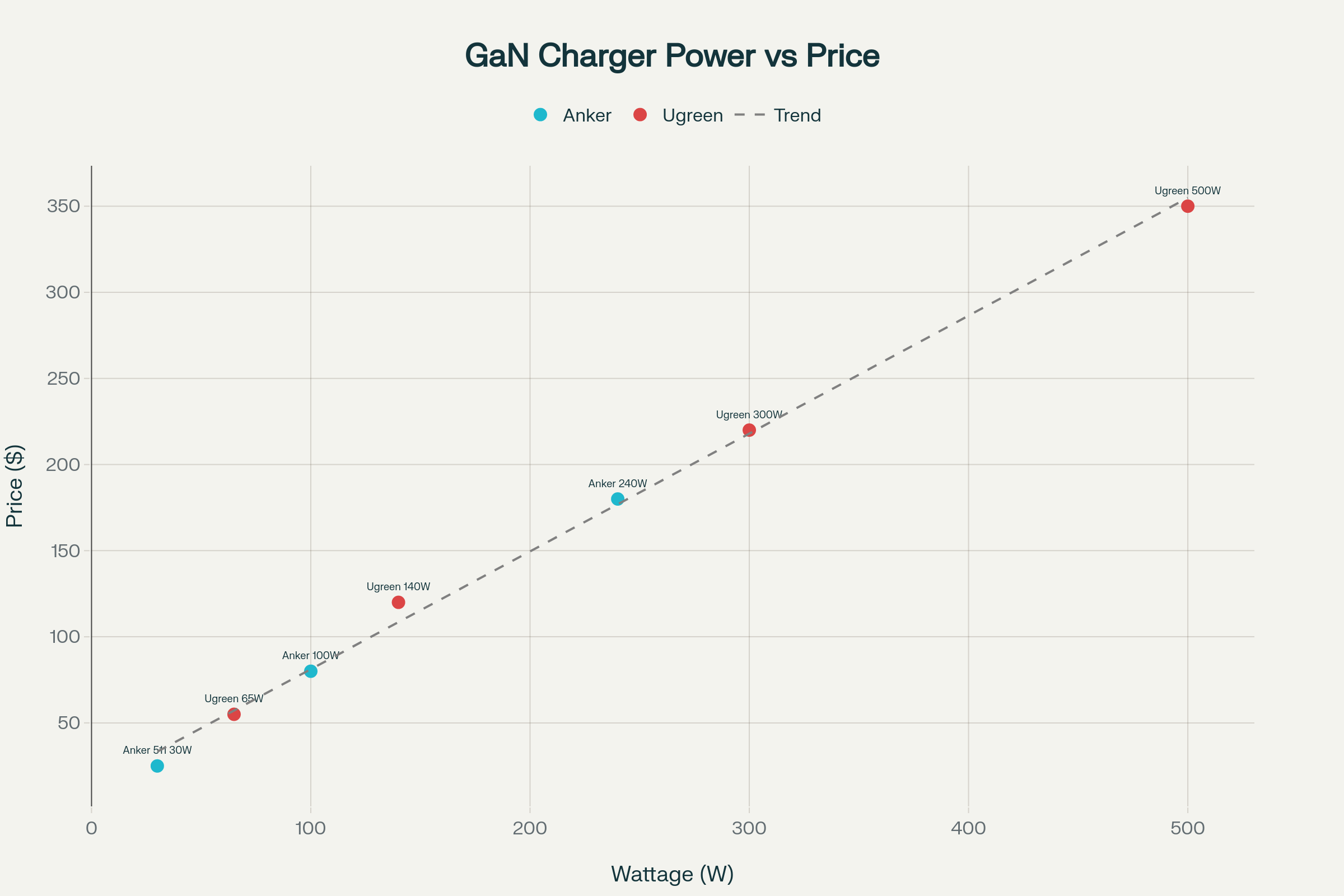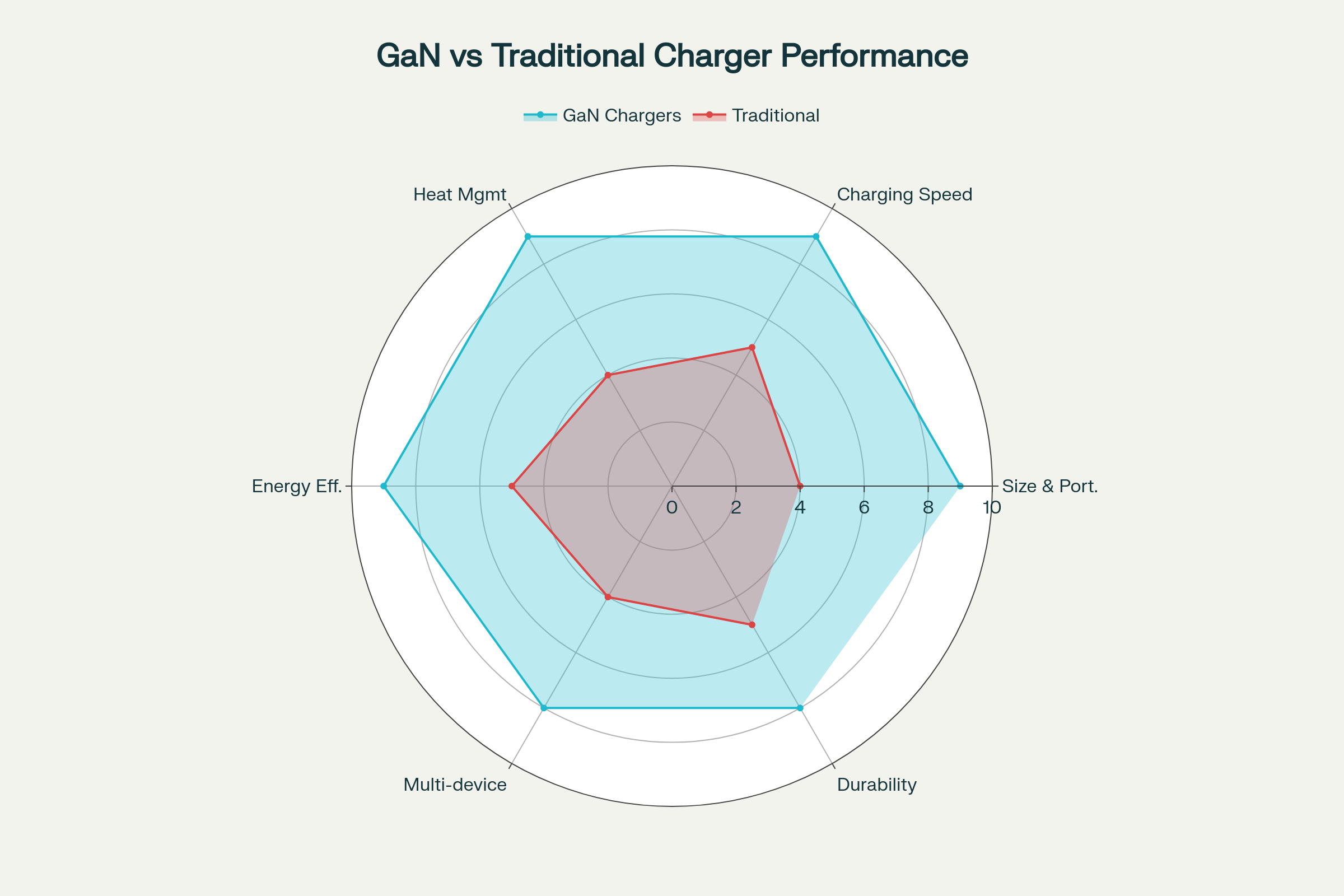Choosing GaN Chargers for Different Purposes and Users: A Comprehensive Comparison Guide
The global GaN-powered charger market has experienced explosive growth, reaching $1.32 billion in 2025 and projected to grow at a remarkable 24.84% CAGR to $7.81 billion by 2033. This revolutionary technology represents a fundamental shift from traditional silicon-based chargers, offering superior efficiency, compact design, and faster charging capabilities that are transforming how we power our devices.
Understanding GaN Technology: The Foundation of Modern Charging
Gallium Nitride (GaN) represents a breakthrough in semiconductor technology, replacing traditional silicon in power conversion circuits. This crystal-like material offers a significantly wider bandgap (3.4 eV) compared to silicon's 1.12 eV, enabling higher voltage handling, reduced electrical resistance, and superior thermal conductivity. The result is a charging solution that delivers up to 3x faster charging speeds while operating in devices up to 50% smaller and lighter than conventional alternatives.
The efficiency advantages are substantial, with GaN chargers achieving over 90% power conversion efficiency compared to traditional chargers' 80-85% efficiency. This improvement translates to less energy waste, reduced heat generation, and lower electricity costs for users. Moreover, GaN chargers generate significantly less electromagnetic interference (EMI), making them safer for use around sensitive electronics.
Wattage-Based Recommendations and Target Groups

GaN Charger Wattage Recommendations by User Type
The choice of appropriate GaN charger wattage depends primarily on intended use cases and device requirements. Our comprehensive analysis reveals distinct categories serving different user needs and applications.
30W GaN Chargers: Ultra-Portable Single-Device Solutions
Target Users: Smartphone users, casual travelers, minimalists Ideal Applications: Daily phone charging, earbuds, smartwatches Key Models: Anker 511 Nano 3 ($25), compact travel chargers
The 30W category serves users prioritizing ultimate portability over multi-device capability. These ultra-compact chargers excel at fast smartphone charging, delivering 0-50% charge in approximately 30 minutes for most modern phones. However, they're limited to single-device use and cannot adequately power laptops or tablets simultaneously.
65W GaN Chargers: The Universal Sweet Spot
Target Users: Students, business professionals, most laptop users Ideal Applications: Ultrabooks, tablets, smartphones, Nintendo Switch Key Models: Ugreen Nexode 65W ($55), Anker 735 Nano II
The 65W range represents the optimal balance for most users, providing full-speed charging for ultrabooks while simultaneously fast-charging smartphones. These chargers can power a MacBook Air from 0-70% in about one hour while maintaining 20W fast-charging capability for phones. This category offers exceptional versatility, supporting most modern laptops including MacBook Air, Dell XPS 13, and HP Spectre models.
100W GaN Chargers: Power User Performance
Target Users: Creative professionals, software developers, power users Ideal Applications: High-performance laptops, multi-device setups Key Models: Anker Prime 100W ($80), Ugreen Nexode 100W
The 100W tier serves users with demanding power requirements, supporting virtually any USB-C laptop including the powerful 16-inch MacBook Pro. These chargers excel at multi-device charging, capable of delivering 65W to laptops while simultaneously providing 30W for tablets. They're particularly valuable for creative workflows requiring sustained high-power operation.
140W+ GaN Chargers: Ultimate Performance Stations
Target Users: Gaming laptop users, workstation operators, multi-device environments Ideal Applications: Gaming laptops, workstations, desktop replacement Key Models: Ugreen Nexode 140W ($120), Anker Prime 240W Desktop ($180)
High-wattage GaN chargers serve the most demanding applications, supporting ultra-fast laptop charging and comprehensive multi-device setups. The 140W models can fully charge a 16-inch MacBook Pro in under two hours while supporting additional devices. Desktop models like the Ugreen Nexode 500W ($350) represent the pinnacle, capable of powering five laptops simultaneously with up to 240W single-port output.
Popular GaN Charger Model Comparisons

GaN Charger Price vs Power Comparison
Our analysis of popular models reveals clear price-to-performance relationships across different manufacturers. Ugreen consistently offers competitive pricing, particularly in higher-wattage categories, while Anker maintains premium positioning with enhanced build quality and warranty support.
The most cost-effective options include the Anker 511 Nano 3 for basic needs and Ugreen Nexode 65W for mainstream applications. For users requiring maximum power, the Ugreen Nexode 500W provides exceptional value at $350, delivering capabilities that would traditionally require multiple separate chargers.
Device-Specific Power Requirements and Recommendations
Understanding device power requirements is crucial for optimal charger selection. Smartphones typically require 18-45W for fast charging, with flagship models supporting higher wattages for rapid power delivery. Tablets like the iPad Pro need 30-45W for full-speed charging, while gaming handhelds including Steam Deck and Nintendo Switch operate optimally with 18-45W input.
Laptop requirements vary significantly by category. Ultrabooks generally need 30-65W, MacBook Air models require 30-45W, while MacBook Pro 13" uses 65W standard. High-performance MacBook Pro 16" models need 96-140W, and gaming laptops often require 100-200W+ for optimal operation. Workstations may demand 200W+ for sustained performance under load.
The charging time improvements with GaN technology are substantial: smartphones experience 2-3x faster charging, while laptops see 1.5-2x improvement depending on power requirements and charger capability. These improvements translate to significant productivity gains, particularly for mobile professionals and frequent travelers.
GaN vs Traditional Charger Performance Analysis

GaN vs Traditional Charger Performance Comparison
The performance advantages of GaN technology extend across multiple dimensions. Size and portability represent the most immediately apparent benefits, with GaN chargers achieving up to 50% size reduction while maintaining or exceeding power output. Heat management shows dramatic improvement, with GaN chargers running significantly cooler due to higher conversion efficiency.
Energy efficiency differences are substantial, with GaN achieving 90%+ efficiency compared to traditional chargers' 80-85% performance. This translates to measurable electricity bill reductions over time, particularly for users operating multiple high-power devices. Multi-device support capabilities are enhanced through intelligent power distribution systems that traditional chargers cannot match.
Safety Considerations and Quality Standards
Safety represents a critical consideration in GaN charger selection, with market analysis revealing significant quality variations. Certified chargers featuring UL, CE, and FCC markings provide essential safety assurance, while uncertified alternatives pose serious risks including overheating, fire hazards, and device damage.
Modern GaN chargers incorporate comprehensive protection systems including overvoltage, overcurrent, overtemperature, and short-circuit protection. Advanced models feature thermal management systems and intelligent charging protocols that adjust power delivery based on device requirements and operating conditions.
However, the market includes concerning safety failures, with some products recalled due to insufficient earthing, inadequate fuse protection, and fire risks. Users should prioritize established brands with proper certifications and avoid unknown manufacturers, particularly for high-wattage applications.
Target Group Recommendations and Use Case Analysis
Students: Balanced Performance and Affordability
Recommended Wattage: 65W Key Requirements: Laptop charging, phone charging, portability, budget-consciousness Optimal Models: Ugreen Nexode 65W, Anker 735 Nano II Price Range: $35-65
Students benefit most from 65W chargers offering comprehensive device support without premium pricing. These chargers handle typical student laptops while providing fast phone charging and excellent portability for campus mobility.
Business Professionals: Reliability and Multi-Device Support
Recommended Wattage: 65-100W Key Requirements: Professional reliability, multi-device support, meeting preparedness Optimal Models: Anker Prime 100W, Ugreen Nexode 100W Price Range: $60-120
Professional users require dependable performance across multiple devices, with emphasis on reliable operation during critical business activities. The 100W tier provides sufficient power for professional laptops while supporting tablets and phones simultaneously.
Content Creators: High-Power Performance
Recommended Wattage: 100-140W Key Requirements: High-power laptops, camera equipment, tablets, sustained operation Optimal Models: Ugreen Nexode 140W, Anker Prime 140W Price Range: $80-150
Creative professionals demand sustained high-power delivery for intensive applications including video editing, 3D rendering, and color-critical work. The 140W tier ensures laptops maintain peak performance while supporting additional creative hardware.
Gaming Enthusiasts: Maximum Power and Multi-Device Support
Recommended Wattage: 100-200W+ Key Requirements: Gaming laptops, multiple peripherals, high sustained power Optimal Models: Ugreen Nexode 200W+, Anker Prime 200W+ Price Range: $120-300
Gaming applications require maximum power delivery with capability for multiple high-drain devices. Gaming laptops often exceed 100W requirements, particularly during intensive gaming sessions, making 200W+ chargers essential for optimal performance.
Frequent Travelers: Compact Efficiency
Recommended Wattage: 65W Key Requirements: Compact size, universal compatibility, durability, airline compliance Optimal Models: Ugreen Nexode 65W, Anker 735 Nano II Price Range: $35-65
Travel applications prioritize size and weight optimization while maintaining sufficient power for laptop and phone charging. The 65W category provides optimal balance between capability and portability for most travel scenarios.
Market Trends and Future Outlook
The GaN charger market continues rapid evolution, with 2025 developments including retractable cable designs, ultra-thin form factors, and enhanced desktop charging stations. Multi-port desktop chargers are emerging as workspace solutions, with models like the Ugreen Nexode 500W setting new standards for simultaneous device charging.
Regulatory trends favor energy-efficient charging solutions, with increasing emphasis on environmental impact reduction. The shift toward USB-C standardization continues accelerating GaN adoption, as manufacturers design chargers supporting the latest Power Delivery standards including PD 3.1 with 240W capability.
Price trends indicate continued market maturation, with increasing competition driving costs downward while performance improvements continue. Industry analysts project mainstream adoption will accelerate through 2025-2027 as price points reach broader market acceptance levels.
Common Mistakes to Avoid
Critical selection errors include prioritizing price over certification, which can result in safety hazards and device damage. Users should avoid ignoring regional voltage standards, ensuring chargers support appropriate input voltages and plug types for intended markets.
Overlooking GaN technology in favor of traditional chargers represents a significant missed opportunity, as GaN provides superior performance at increasingly competitive pricing. Compatibility assumptions without verification can lead to suboptimal charging performance or device incompatibility.
Insufficient wattage selection results in slow charging and inability to power devices under load, while excessive wattage without corresponding multi-device benefits wastes resources. Users should match charger capabilities to actual device requirements and usage patterns.
Conclusion
GaN charger technology represents a fundamental advancement in power delivery, offering superior efficiency, compact design, and enhanced safety compared to traditional alternatives. The optimal choice depends on individual requirements, device portfolios, and usage patterns, with clear categories serving different user needs from basic smartphone charging to comprehensive multi-device power stations.
The market's rapid growth trajectory, combined with improving price-performance ratios and expanding safety standards, positions GaN chargers as the definitive solution for modern charging requirements. Users should prioritize certified products from established manufacturers, match wattage to actual needs, and consider future expansion when making selection decisions.
As the technology continues maturing and costs decrease, GaN chargers will likely become the standard charging solution across all categories, making current investment in quality GaN technology a forward-looking decision that will serve users effectively for years to come.



Comments
Post a Comment